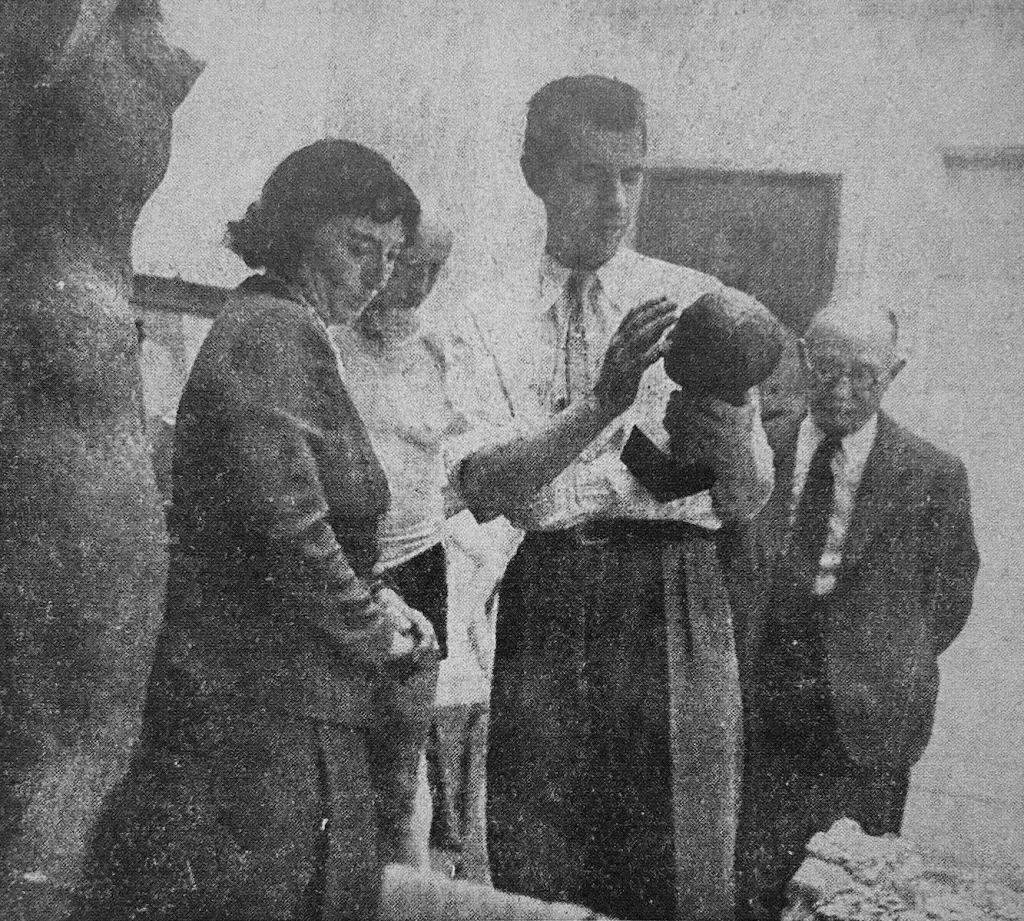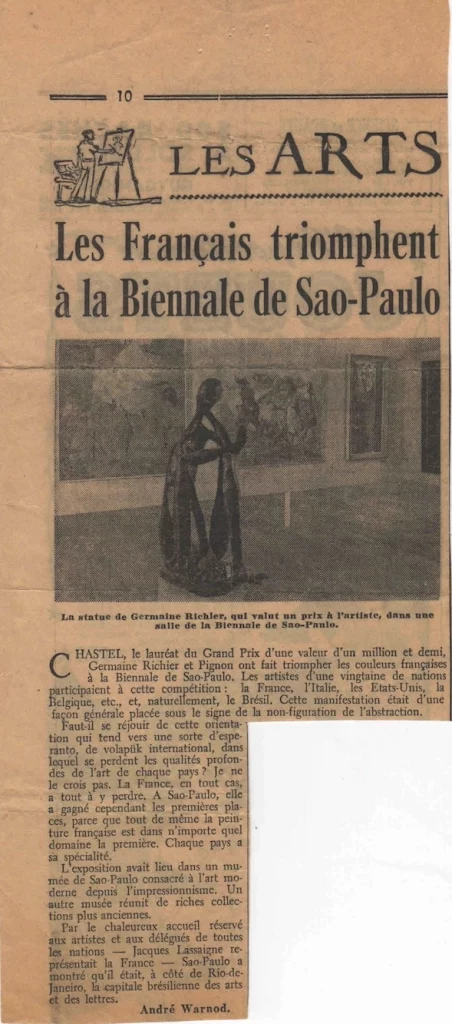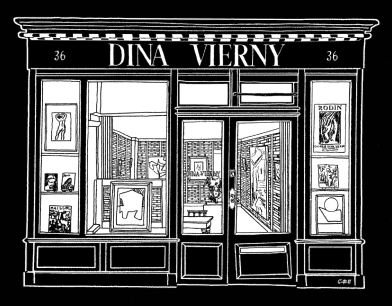All Exhibitions here
In 1951, on the occasion of the inaugural edition of the São Paulo Biennial, Robert Couturier and Germaine Richier - linked by a 20-year friendship and a prolific artistic partnership - were both chosen to represent the sculpture section of France within the pavilion designed by Jean Cassou, director of the French National Museum of Modern Art. The São Paulo Biennial is the second oldest art biennial in the world after Venice.March 2, 2024
 "Germaine Richier and Robert Couturier", São Paulo Biennal, 1951 © Archives Fundação Bienal de São Paulo
"Germaine Richier and Robert Couturier", São Paulo Biennal, 1951 © Archives Fundação Bienal de São Paulo Germaine Richier and Robert Couturier were linked to each other throughout their careers. Their artistic journeys began in the late 1920s, influenced by master sculptors of their time: Couturier studied under Aristide Maillol (1861-1944) and Richier under Antoine Bourdelle (1861-1929). An unwavering friendship blossomed between them in the early 1930s, a period during which their respective artistic styles developed. Their talent was recognized and praised with the Blumenthal Prize, awarded to Couturier in 1930 and Richier in 1936. Their bonds of friendship remained rich in exchanges and sharing of ideas, despite the geographical distance between the artists, until Germaine Richier death in 1959.


"Germaine Richier and Robert Couturier in Hermann Haller's studio in Zurich in 1946" © all right reserved
The post-war years marked a period of international recognition for their works. They participated together in several biennials and exhibitions before 1951: the Anglo-French Art exhibition in London in 1947, "Contemporary Sculptors of the École de Paris" at the Kunsthalle in Bern in 1948, and "Thirteen Sculptors of the École de Paris" at the Stedelijk Museum in Amsterdam the same year. Two years later, Couturier participated in the French Pavilion at the Venice Biennale, before Germaine Richier joined in 1952. In the meantime, they reunited again in 1951 in São Paulo. These events played a crucial role in highlighting different artistic trends, particularly those grouped under the term École de Paris, of which sculptors like Germaine Richier, Alberto Giacometti, and Robert Couturier were key figures. Their sculptures, characterized by their "lean" and "expressionist" appearance, stood out for their elongated, disembodied structure and the irregularity of their material.

« Germaine Richier and Robert Couturier, Biennale de São Paulo », 1951 © Archives Fundação Bienal de São Paulo

« Germaine Richier and Robert Couturier », Biennale de São Paulo, 1951 © Cav. Giov. Strazza
The scene of a remarkable confusion, this São Paulo Biennial remains significant for the two artists: in an article by André Warnod published in Le Figaro, Germaine Richier is announced as the winner of a prize, alongside a reproduction of a sculpture by Robert Couturier falsely identified as being by Germaine Richier. This ambiguous situation led to the acquisition of "La Forêt" (1946) by Germaine Richier by the São Paulo Museum of Modern Art, while the sculpture "Jeune fille lamelliforme" (1950) by Robert Couturier was purchased by the Museum of Modern Art in Rio. In 1994, Robert Couturier recalled this incident with perplexity: "There was, as with the Venice Biennale, a sculpture prize and a painting prize. I was invited and I sent a sculpture, the Jeune fille lamelliforme. I received a paper informing me that my sculpture had been purchased by the museum in Rio de Janeiro. The prize consisted of a purchase. It was a purchase prize and so it was attributed to me. However, it was Germaine Richier who received the prize and only received the money a few years later. So, I wrote to the museum asking them to send me the winning sculpture, which was mine. I then met Jean Cassou, who was the curator of the French pavilion at this biennale, but he never gave me any explanation about what had happened. The work was photographed with a wrong caption and reproduced in an article by André Warnod in Le Figaro."

André Warnod, « les Français triomphent à la biennale de São Paulo », Le Figaro, 1951

View of the exhibition "Couturier-Richier: Une amitié sculpturale" at the Dina Vierny Gallery in 2023 © Romain Darnaud
The post-war years marked a period of international recognition for their works. They participated together in several biennials and exhibitions before 1951: the Anglo-French Art exhibition in London in 1947, "Contemporary Sculptors of the École de Paris" at the Kunsthalle in Bern in 1948, and "Thirteen Sculptors of the École de Paris" at the Stedelijk Museum in Amsterdam the same year. Two years later, Couturier participated in the French Pavilion at the Venice Biennale, before Germaine Richier joined in 1952. In the meantime, they reunited again in 1951 in São Paulo. These events played a crucial role in highlighting different artistic trends, particularly those grouped under the term École de Paris, of which sculptors like Germaine Richier, Alberto Giacometti, and Robert Couturier were key figures. Their sculptures, characterized by their "lean" and "expressionist" appearance, stood out for their elongated, disembodied structure and the irregularity of their material.
 "Germaine Richier and Robert Couturier", São Paulo Biennal, 1951 © Archives Fundação Bienal de São Paulo
"Germaine Richier and Robert Couturier", São Paulo Biennal, 1951 © Archives Fundação Bienal de São Paulo In 1951, on the occasion of the inaugural edition of the São Paulo Biennial, Robert Couturier and Germaine Richier - linked by a 20-year friendship and a prolific artistic partnership - were both chosen to represent the sculpture section of France within the pavilion designed by Jean Cassou, director of the French National Museum of Modern Art. The São Paulo Biennial is the second oldest art biennial in the world after Venice.
Germaine Richier and Robert Couturier were linked to each other throughout their careers. Their artistic journeys began in the late 1920s, influenced by master sculptors of their time: Couturier studied under Aristide Maillol (1861-1944) and Richier under Antoine Bourdelle (1861-1929). An unwavering friendship blossomed between them in the early 1930s, a period during which their respective artistic styles developed. Their talent was recognized and praised with the Blumenthal Prize, awarded to Couturier in 1930 and Richier in 1936. Their bonds of friendship remained rich in exchanges and sharing of ideas, despite the geographical distance between the artists, until Germaine Richier death in 1959.
The post-war years marked a period of international recognition for their works. They participated together in several biennials and exhibitions before 1951: the Anglo-French Art exhibition in London in 1947, "Contemporary Sculptors of the École de Paris" at the Kunsthalle in Bern in 1948, and "Thirteen Sculptors of the École de Paris" at the Stedelijk Museum in Amsterdam the same year. Two years later, Couturier participated in the French Pavilion at the Venice Biennale, before Germaine Richier joined in 1952. In the meantime, they reunited again in 1951 in São Paulo. These events played a crucial role in highlighting different artistic trends, particularly those grouped under the term École de Paris, of which sculptors like Germaine Richier, Alberto Giacometti, and Robert Couturier were key figures. Their sculptures, characterized by their "lean" and "expressionist" appearance, stood out for their elongated, disembodied structure and the irregularity of their material.

« Germaine Richier and Robert Couturier, Biennale de São Paulo », 1951 © Archives Fundação Bienal de São Paulo

« Germaine Richier and Robert Couturier », Biennale de São Paulo, 1951 © Cav. Giov. Strazza
The scene of a remarkable confusion, this São Paulo Biennial remains significant for the two artists: in an article by André Warnod published in Le Figaro, Germaine Richier is announced as the winner of a prize, alongside a reproduction of a sculpture by Robert Couturier falsely identified as being by Germaine Richier. This ambiguous situation led to the acquisition of "La Forêt" (1946) by Germaine Richier by the São Paulo Museum of Modern Art, while the sculpture "Jeune fille lamelliforme" (1950) by Robert Couturier was purchased by the Museum of Modern Art in Rio. In 1994, Robert Couturier recalled this incident with perplexity: "There was, as with the Venice Biennale, a sculpture prize and a painting prize. I was invited and I sent a sculpture, the Jeune fille lamelliforme. I received a paper informing me that my sculpture had been purchased by the museum in Rio de Janeiro. The prize consisted of a purchase. It was a purchase prize and so it was attributed to me. However, it was Germaine Richier who received the prize and only received the money a few years later. So, I wrote to the museum asking them to send me the winning sculpture, which was mine. I then met Jean Cassou, who was the curator of the French pavilion at this biennale, but he never gave me any explanation about what had happened. The work was photographed with a wrong caption and reproduced in an article by André Warnod in Le Figaro."

View of the exhibition "Couturier-Richier: Une amitié sculpturale" at the Dina Vierny Gallery in 2023 © Romain Darnaud
